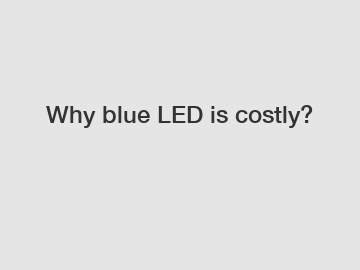Why blue LED is costly?
In the realm of lighting technology, blue LEDs have been a pivotal innovation, revolutionizing everything from displays to energy-efficient lighting solutions. However, have you ever wondered why blue LEDs tend to be more expensive than their red and green counterparts? In this blog, we dive into the fascinating world of blue LED lights, exploring the reasons behind their higher costs and shedding light on the intricate processes that make them so valuable.
1. The Intricate Chemistry of Blue LED Production:
To understand why blue LEDs are costly, we must first appreciate the complexity involved in their manufacturing process. Unlike red and green LEDs, which are relatively easier to produce, blue LEDs require a more intricate chemistry. The art of synthesizing blue light emission with high efficiency involves complex materials, such as gallium nitride, which necessitate costly manufacturing techniques and specialized equipment.

2. Sophisticated Manufacturing Equipment:
Creating blue LEDs involves intense precision and delicacy. During production, the deposition of thin layers of semiconductor materials is crucial, requiring expensive machinery to accomplish optimal results. These advanced manufacturing systems come with a hefty price tag, contributing to the increased cost of blue LED lights.
3. Research and Development Costs:
Science and innovation are at the core of blue LED technology. The journey to develop this breakthrough technology involved countless years of research, development, and experimentation. The investment required to fund extensive studies and breakthrough discoveries translates into higher costs for blue LEDs in comparison to their less intricate counterparts.
4. Patent Restrictions:
Patents play a significant role in the cost of blue LEDs. The early pioneers in blue LED technology filed patents to safeguard their intellectual property and rightful ownership. While these patents enable inventors to receive recognition and compensation for their groundbreaking contributions, they also lead to monopolies that can inflate the market price. As these patents gradually expire or become more accessible, the cost of blue LEDs may eventually decrease.
5. Market Demand and Supply:
Blue LEDs have become an integral component of various high-tech applications, including smartphones, televisions, and even automotive lighting. The surging demand for blue LED products amplifies the manufacturing costs, as manufacturers strive to meet the market's needs while maintaining high quality. The intricate fabrication processes and limited supply also contribute to their higher price, with manufacturers ensuring a balance between quality and affordability.
6. Energy Efficiency and Lifespan:
One of the primary reasons blue LEDs gained popularity is their superior energy efficiency and extended lifespan compared to traditional incandescent bulbs. Despite their initial higher cost, the drastic reduction in power consumption and long-lasting durability make blue LEDs a cost-effective, environmentally friendly investment in the long run. It is essential to consider this aspect when contemplating the apparent expense of blue LED lights.
7. Technological Advancement and Competition:
As technology evolves, so does the cost of manufacturing. Over time, advancements in blue LED production techniques are likely to make the process more streamlined and cost-effective. Furthermore, as more manufacturers enter the market, competition will intensify, leading to a potential decline in prices. The progress witnessed in the LED industry already indicates a positive trajectory towards more accessible blue LED options in the future.
Conclusion:
The higher cost of blue LED lights can be attributed to a combination of factors, including intricate manufacturing processes, sophisticated equipment, significant research and development investments, patent restrictions, market demand and supply, and technological advancements. While blue LEDs may appear costly initially, their superior energy efficiency and extended lifespan make them an investment worth considering. As time progresses, we can anticipate the costs to decrease as innovation continues to push forward, making blue LED lights more affordable and accessible to all.
If you want to learn more, please visit our website smd led package sizes, 3528 smd led wattage, smd 3535 led price.
350
0
0


Comments
All Comments (0)